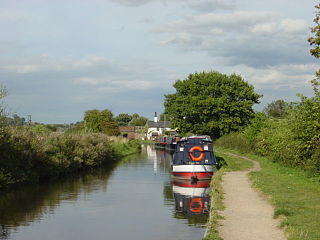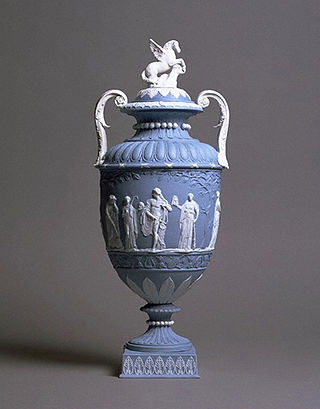
Josiah Wedgwood was an English potter, entrepreneur and abolitionist. Founding the Wedgwood company in 1759, he developed improved pottery bodies by systematic experimentation, and was the leader in the industrialisation of the manufacture of European pottery.

The Trent and Mersey Canal is a 93+1⁄2-mile (150 km) canal in Derbyshire, Staffordshire and Cheshire in north-central England. It is a "narrow canal" for the vast majority of its length, but at the extremities to the east of Burton upon Trent and north of Middlewich, it is a wide canal.

James Brindley was an English engineer. He was born in Tunstead, Derbyshire, and lived much of his life in Leek, Staffordshire, becoming one of the most notable engineers of the 18th century.

The Etruria Works was a ceramics factory opened by Josiah Wedgwood in 1769 in a district of Stoke-on-Trent, Staffordshire, England, which he named Etruria. The factory ran for 180 years, as part of the wider Wedgwood business.

Thomas Whieldon was an English potter who played a leading role in the development of Staffordshire pottery.

Josiah Spode was an English potter and the founder of the English Spode pottery works which became famous for the high quality of its wares. He is often credited with the establishment of blue underglaze transfer printing in Staffordshire in 1781–84, and with the definition and introduction in c. 1789–91 of the improved formula for bone china which thereafter remained the standard for all English wares of this kind.
Wedgwood is a British pottery firm founded by Josiah Wedgwood.

The Staffordshire Potteries is the industrial area encompassing the six towns Burslem, Fenton, Hanley, Longton, Stoke and Tunstall, which is now the city of Stoke-on-Trent in Staffordshire, England. North Staffordshire became a centre of ceramic production in the early 17th century, due to the local availability of clay, salt, lead and coal.

Tunstall is one of the six towns that, along with Burslem, Longton, Fenton, Hanley and Stoke-upon-Trent, amalgamated to form the City of Stoke-on-Trent in Staffordshire, England. It was one of the original six towns that federated to form the city. Tunstall is the most northern, and fourth largest town of the Potteries. It is situated in the very northwest of the city borough, with its north and west boundaries being the city limit. It stands on a ridge of land between Fowlea Brook to the west and Scotia Brook to the east, surrounded by old tile making and brick making sites, some of which date back to the Middle Ages.

Jasperware, or jasper ware, is a type of pottery first developed by Josiah Wedgwood in the 1770s. Usually described as stoneware, it has an unglazed matte "biscuit" finish and is produced in a number of different colours, of which the most common and best known is a pale blue that has become known as Wedgwood Blue. Relief decorations in contrasting colours are characteristic of jasperware, giving a cameo effect. The reliefs are produced in moulds and applied to the ware as sprigs.

Etruria Hall in Etruria, Stoke-on-Trent, Staffordshire, England is a Grade II listed house and former home of the potter Josiah Wedgwood. It was built between 1768–1771 by Joseph Pickford. The hall was sold by the Wedgwoods in the 19th century and is now part of a hotel.
John Wedgwood, the eldest son of the potter Josiah Wedgwood, was a partner in the Wedgwood pottery firm 1790–1793 and again 1800–1812.

Wedgwood is an English fine china, porcelain and luxury accessories manufacturer that was founded on 1 May 1759 by the potter and entrepreneur Josiah Wedgwood and was first incorporated in 1895 as Josiah Wedgwood and Sons Ltd. It was rapidly successful and was soon one of the largest manufacturers of Staffordshire pottery, "a firm that has done more to spread the knowledge and enhance the reputation of British ceramic art than any other manufacturer", exporting across Europe as far as Russia, and to the Americas. It was especially successful at producing fine earthenware and stoneware that were accepted as equivalent in quality to porcelain but were considerably cheaper.
Enoch Wedgwood (1813-1879) was an English potter, founder in 1860 of the pottery firm Wedgwood & Co of Tunstall, Stoke-on-Trent. He was a distant cousin of the famous potter Josiah Wedgwood, of Josiah Wedgwood & Sons but their two businesses were separate concerns.

John Astbury (1688–1743) was an English potter credited with innovations and improvements in earthenware associated with Staffordshire figures.

Emma Crewe was a British artist known for her designs for Josiah Wedgwood, and for her botanical art.
Ralph Wedgwood (1766–1837) was an English inventor and member of the Wedgwood family of potters. His most notable invention was the earliest form of carbon paper, a method of creating duplicate paper documents, which he called "stylographic writer" or Noctograph. He obtained a patent for the invention in 1806.

Elizabeth Upton, Baroness Templetown was an English artist whose designs were used by Josiah Wedgwood the potter. She specialised in detailed cut-paper work which adapted well to Wedgwood's jasperware with white bas relief scenes on coloured backgrounds. He first chose one of her designs in 1783, and his 1787 catalogue referred to her "exquisite taste" and "charming groups". Several of the designs Wedgwood used have a feminine or domestic theme. She also painted in watercolours and sculpted in clay. Of particular note were her sculptures of family, including grandchildren. A famous bust was made of her son-in-law the Marquess of Bristol.

The Ridgway family was one of the important dynasties manufacturing Staffordshire pottery, with a large number of family members and business names, over a period from the 1790s to the late 20th century. In their heyday in the mid-19th century there were several different potteries run by different branches of the family. Most of their wares were earthenware, but often of very high quality, but stoneware and bone china were also made. Many earlier pieces were unmarked and identifying them is difficult or impossible. Typically for Staffordshire, the various businesses, initially set up as partnerships, changed their official names rather frequently, and often used different trading names, so there are a variety of names that can be found.

The Turner family of potters was active in Staffordshire, England 1756-1829. Their manufactures have been compared favourably with, and sometimes confused with, those of Josiah Wedgwood and Sons. Josiah Wedgwood was both a friend and a commercial rival of John Turner the elder, the first notable potter in the family.




















